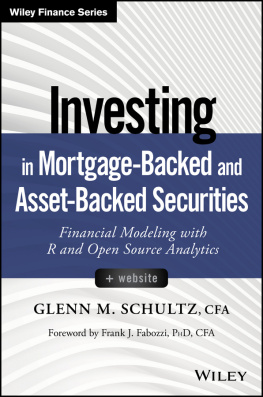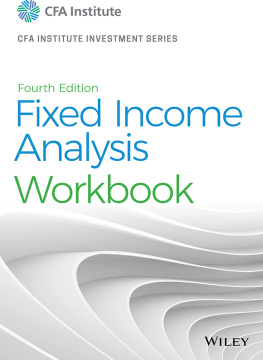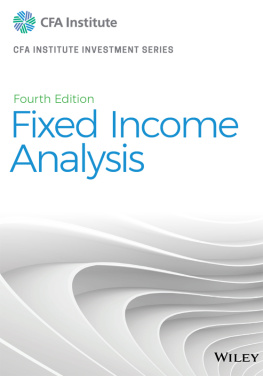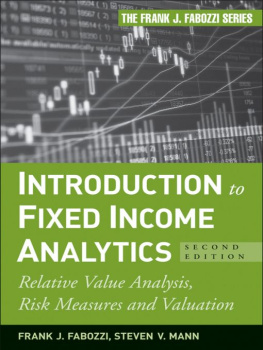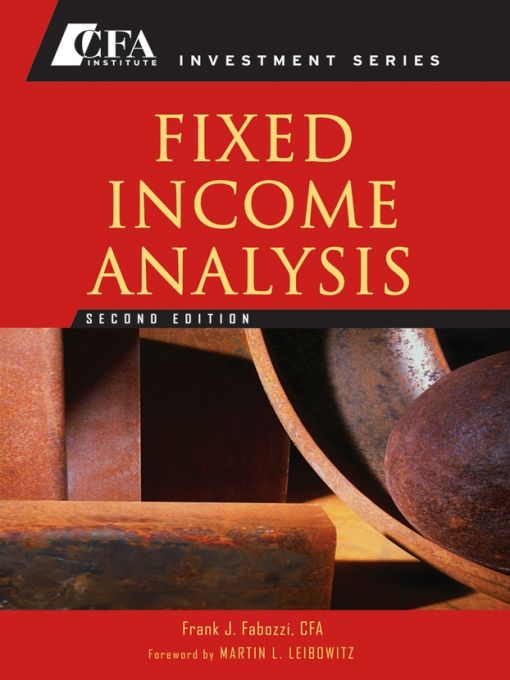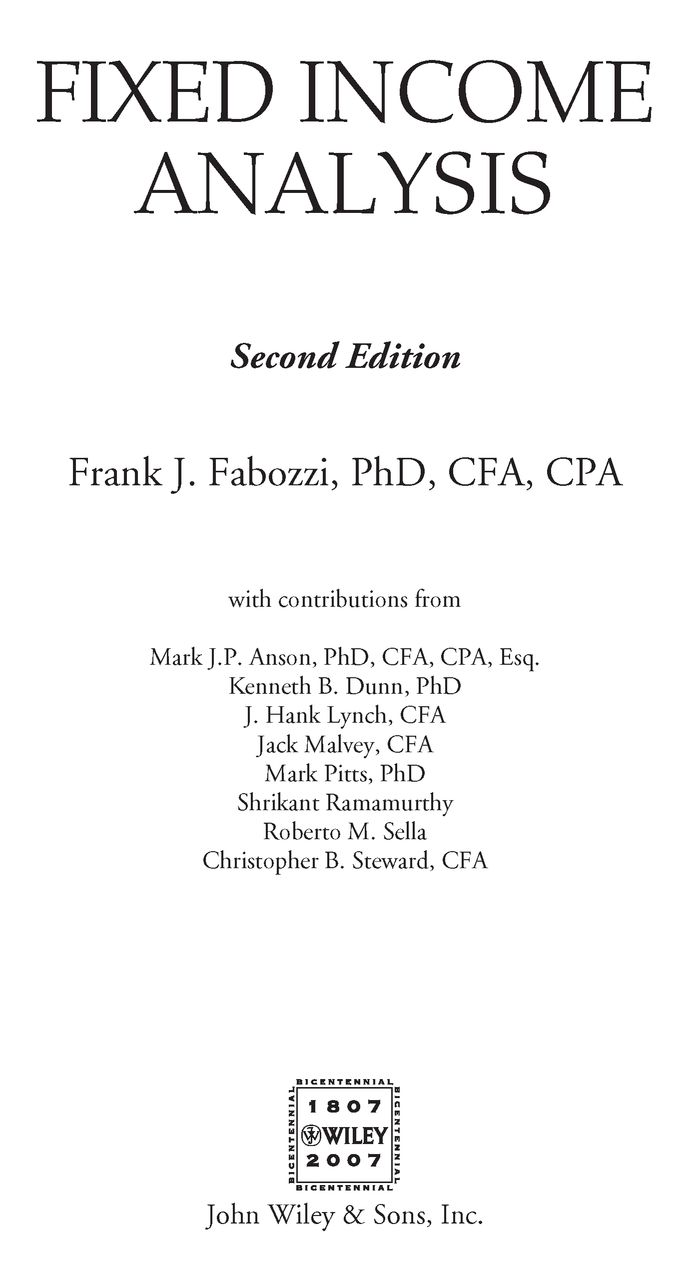Table of Contents
CFA Institute is the premier association for investment professionals around the world, with over 85,000 members in 129 countries. Since 1963 the organization has developed and administered the renowned Chartered Financial Analyst Program. With a rich history of leading the investment profession, CFA Institute has set the highest standards in ethics, education, and professional excellence within the global investment community, and is the foremost authority on investment profession conduct and practice.
Each book in the CFA Institute Investment Series is geared toward industry practitioners along with graduate-level finance students and covers the most important topics in the industry. The authors of these cutting-edge books are themselves industry professionals and academics and bring their wealth of knowledge and expertise to this series.
FOREWORD
There is an argument that an understanding of any financial market must incorporate an appreciation of the functioning of the bond market as a vital source of liquidity. This argument is true in todays financial markets more than ever before, because of the central role that debt plays in virtually every facet of our modern financial markets. Thus, anyone who wants to be a serious student or practitioner in finance should at least become familiar with the current spectrum of fixed income securities and their associated derivatives and structural products.
This book is a fully revised and updated edition of two volumes used earlier in preparation for the Chartered Financial Analysts (CFA) program. However, in its current form, it goes beyond the original CFA role and provides an extraordinarily comprehensive, and yet quite readable, treatment of the key topics in fixed income analysis. This breadth and quality of its contents has been recognized by its inclusion as a basic text in the finance curriculum of major universities. Anyone who reads this book, either thoroughly or by dipping into the portions that are relevant at the moment, will surely reach new planes of knowledgeability about debt instruments and the liquidity they provide throughout the global financial markets.
I first began studying the bond market back in the 1960s. At that time, bonds were thought to be dull and uninteresting. I often encountered expressions of sympathy about having been misguided into one of the more moribund backwaters in finance. Indeed, a designer of one of the early bond market indexes (not me) gave a talk that started with a declaration that bonds were dull, dull, dull!
In those early days, the bond market consisted of debt issued by US Treasury, agencies, municipalities, or high grade corporations. The structure of these securities was generally quite plain vanilla: fixed coupons, specified maturities, straightforward call features, and some sinking funds. There was very little trading in the secondary market. New issues of tax exempt bonds were purchased by banks and individuals, while the taxable offerings were taken down by insurance companies and pension funds. And even though the total outstanding footings were quite sizeable relative to the equity market, the secondary market trading in bonds was miniscule relative to stocks.
Bonds were, for the most part, locked away in frozen portfolios. The coupons were stillliterallyclipped, and submitted to receive interest payments (at that time, scissors were one of the key tools of bond portfolio management). This state of affairs reflected the environment of the daythe bond-buying institutions were quite traditional in their culture (the term crusty may be only slightly too harsh), bonds were viewed basically as a source of income rather than an opportunity for short-term return generation, and the high transaction costs in the corporate and municipal sectors dampened any prospective benefit from trading.
However, times change, and there is no area of finance that has witnessed a more rapid evolutionperhaps revolution would be more aptthan the fixed income markets. Interest rates have swept up and down across a range of values that was previously thought to be unimaginable. New instruments were introduced, shaped into standard formats, and then exploded to huge markets in their own right, both in terms of outstanding footings and the magnitude of daily trading. Structuring, swaps, and a variety of options have become integral components of the many forms of risk transfer that make todays vibrant debt market possible.
In stark contrast to the plodding pace of bonds in the 1960s, this book takes the reader on an exciting tour of todays modern debt market. The book begins with descriptions of the current tableau of debt securities. After this broad overview, which I recommend to everyone, the second chapter delves immediately into the fundamental question associated with any investment vehicle: What are the risks? Bonds have historically been viewed as a lower risk instrument relative to other markets such as equities and real estate. However, in todays fixed income world, the derivative and structuring processes have spawned a veritable smorgasbord of investment opportunities, with returns and risks that range across an extremely wide spectrum.
The completion of the Treasury yield curve has given a new clarity to term structure and maturity risk. In turn, this has sharpened the identification of minimum risk investments for specific time periods. The Treasury curves more precisely defined term structure can then help in analyzing the spread behavior of non-Treasury securities. The non-Treasury market consists of corporate, agency, mortgage, municipal, and international credits. Its total now far exceeds the total supply of Treasury debt. To understand the credit/liquidity relationships across the various market segments, one must come to grips with the constellation of yield spreads that affects their pricing. Only then can then one begin to understand how a given debt security is valued and to appreciate the many-dimensional determinants of debt return and risk.
As one delves deeper into the multiple layers of fixed income valuation, it becomes evident that these same factors form the basis for analyzing all forms of investments, not just bonds. In every market, there are spot rates, forward rates, as well as the more aggregated yield measures. In the past, this structural approach may have been relegated to the domain of the arcane or the academic. In the current market, these more sophisticated approaches to capital structure and term effects are applied daily in the valuation process.
Whole new forms of securitized fixed income instruments have come into existence and grown to enormous size in the past few decades, for example, the mortgage backed, asset backed, and structured-loan sectors. These sectors have become critical to the flow of liquidity to households and to the global economy at large. To trace how liquidity and credit availability find their way through various channels to the ultimate demanders, it is critical to understand how these assets are structured, how they behave, and why various sources of funds are attracted to them.
Credit analysis is another area that has undergone radical evolution in the past few years. The simplistic standard ratio measures of yesteryear have been supplemented by market oriented analyses based upon option theory as well as new approaches to capital structure.


